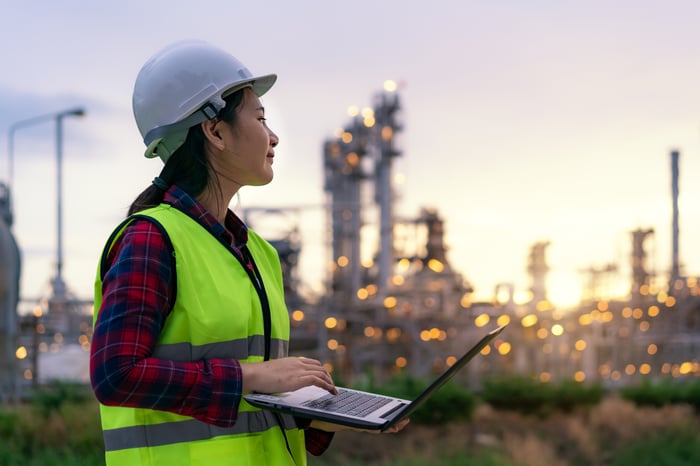By Matthew DiLallo - Jun 4, 2022 - MOTLEY FOOL
KEY POINTS
Exxon sees an enormous market opportunity for carbon capture and storage.
That's leading the oil giant to invest billions of dollars into the market.
It's one of several energy companies working on carbon capture and storage solutions.
The oil giant is pumping billions of dollars into a plan to clean up the oil patch's emissions profile.
ExxonMobil (XOM 1.45%) doesn't believe fossil fuels will become extinct. It sees oil and gas playing a vital role in fueling the economy in the future, even as the adoption of cleaner alternatives accelerates. That's partly due to their lower relative costs and the huge technological leaps needed before replacement fuels like green hydrogen become commercially viable.
Another reason Exxon sees a future for fossil fuels is that it can lower its carbon emissions profile through carbon capture and storage. The oil giant foresees a $4 trillion market opportunity by 2050 for cleaning up the oil patch.
Carbon capture pulls carbon dioxide emissions from fuel combustion and industrial processes out of the air so that it doesn't get into the atmosphere and negatively impact the climate. The captured carbon dioxide then moves on pipelines or ships to underground geological formations for storage. There's also the potential to reuse captured carbon dioxide for other purposes.
One potentially major market for captured carbon dioxide is a process known as enhanced oil recovery (EOR). Oil companies, including Exxon, Occidental Petroleum (OXY 1.43%), Denbury Resources, and Kinder Morgan, pump carbon dioxide into legacy oil formations to increase pressure, resulting in higher production. Many of these companies currently use carbon dioxide produced from underground reservoirs for EOR. However, they're increasingly seeking out captured carbon for EOR purposes.
In addition to EOR, potential uses of captured carbon include manufacturing other fuels like synthetic jet fuel and making building materials like concrete.
Betting big on carbon capture and storage
While carbon dioxide has a range of potential uses, the initial focus of Exxon and others in the energy sector is on sequestering it underground. The company is investing more than $15 billion over the next six years to lower greenhouse gas emissions through carbon capture and storage, hydrogen, and biofuels. It's already the world leader in carbon capture, pulling more carbon dioxide out of the air than any other company.
However, it has grand ambitions to build an even larger carbon capture and storage business. For example, Exxon is working on an up to $100 billion plan to capture carbon produced by petrochemical plants, power generating facilities, and other heavy industries along the Houston Ship Channel. The plan would see industrial facilities install devices to capture carbon dioxide before it leaves their plants. They could either use it to develop products or transport it via pipelines to the Gulf of Mexico, where it will get injected into sub-sea formations.
Exxon is also looking into developing a large-scale carbon capture and storage hub in Australia. It would capture emissions produced by industries in the Gippsland Basin and transport the carbon dioxide to a depleted oilfield off the country's coast via existing pipelines.
Growing interest in capturing carbon
Exxon is one of many energy companies working on developing carbon capture and storage projects. EnLink Midstream (ENLC -0.09%) and Talos Energy (TALO 3.19%) are working to jointly develop a complete carbon capture, transportation, and sequestration solution for industrial-scale carbon dioxide emitters along the Mississippi River. The proposed project would use significant portions of EnLink's pipelines in the region to transport captured carbon dioxide and move it to Talos' River Bend sequestration site in Louisiana.
Meanwhile, EnLink and Enterprise Products Partners (EPD -0.14%) are working with a subsidiary of Occidental Petroleum on potential carbon capture and storage solutions. EnLink's project with Occidental would focus on another section of the Mississippi River corridor, while Enterprise Products Partners is working on developing a project along the Houston Ship Channel. The midstream companies would provide existing and new pipelines to transport captured carbon to sequestration hubs operated by Occidental Petroleum.
Carbon capture could keep the oil patch from going extinct
ExxonMobil believes carbon capture and storage is an answer to the world's energy problem. It can make fossil fuels much cleaner while keeping the costs low compared to alternative fuels. That's leading the oil giant to bet big on the future of carbon capture. If it's correct, that wager could pay big dividends by enabling it to continue producing oil and gas while earning meaningful income from carbon capture and storage.












